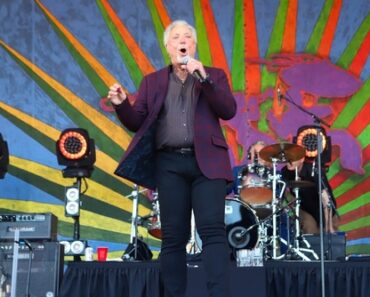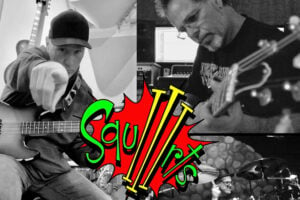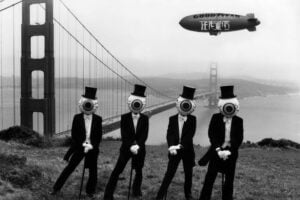Captain Beyond emerged in the early 1970s as a supergroup with a sound that defied conventions, blending hard rock, psychedelia, and progressive elements into a unique sonic tapestry. Hailing from the United States, the band was composed of musicians who had already made their mark in iconic acts, yet were determined to chart new creative territory together. This fusion of talent, vision, and innovation quickly established Captain Beyond as one of the most intriguing acts of their era, even as their trajectory remained relatively short-lived.
The band’s origins can be traced to the dynamic pairing of Rod Evans, the original lead singer of Deep Purple, and Bobby Caldwell, a seasoned drummer and songwriter who had worked with Johnny Winter. Joined by guitarist Larry “Rhino” Reinhardt and bassist Lee Dorman—both of whom had played in Iron Butterfly, another cornerstone of late-1960s rock—Captain Beyond assembled a lineup steeped in musical experience and versatility. This amalgamation of talent gave the band a foundation to push creative boundaries while delivering a distinct and cohesive sound.
Captain Beyond’s self-titled debut album, Captain Beyond (1972), was a groundbreaking release that showcased their adventurous approach to rock music. Featuring a seamless flow between tracks, intricate time signatures, and cosmic lyrics, the album stood apart from the mainstream hard rock of the time. Songs like “Dancing Madly Backwards (On a Sea of Air)” and “Raging River of Fear” demonstrated their ability to balance raw power with technical sophistication, captivating fans of both heavy rock and progressive music. The album’s cult status continues to grow, with its bold fusion of styles often cited as a precursor to genres like stoner rock and doom metal.
Their follow-up effort, Sufficiently Breathless (1973), marked a shift in both sound and personnel. Bobby Caldwell had departed, and the band enlisted drummer Martin Rodriguez to fill the void. This album leaned further into melodic and experimental territory, offering a slightly softer yet equally imaginative take on their musical vision. Despite the departure from the unrelenting intensity of their debut, tracks like “Drifting in Space” and the title track maintained the band’s signature otherworldly feel, solidifying their reputation as a group unafraid to evolve.
Internal changes and challenges would ultimately impact Captain Beyond’s longevity. Following the release of their second album, the band experienced further lineup shifts, with Rod Evans stepping away from the group. Though they briefly re-formed in the late 1970s to release Dawn Explosion (1977), featuring new lead vocalist Willy Daffern, this iteration of the band struggled to capture the same magic as their earlier works. Nevertheless, the album showcased their continued commitment to blending intricate musicianship with powerful, imaginative storytelling.
While Captain Beyond’s initial run was relatively short, their influence on rock music has been enduring. Their bold experimentation and willingness to push boundaries inspired countless bands in the decades that followed, particularly in the realms of progressive and heavy rock. Their music, characterized by its otherworldly themes and innovative structures, remains a touchstone for fans of adventurous rock.
Even as individual members pursued other projects, Captain Beyond’s legacy endured. The band’s music continues to resonate with a loyal fan base and has been rediscovered by new generations seeking the kind of unrestrained creativity and originality that Captain Beyond epitomized. With their roots firmly planted in the traditions of hard rock but their gaze fixed firmly on the future, Captain Beyond left an indelible mark on the musical landscape—a testament to what happens when extraordinary talents unite with an unwavering desire to explore the unknown.
# 10 – Thousand Days Of Yesterdays (Time Since Come And Gone)
“Thousand Days of Yesterdays (Time Since Come and Gone)” exemplifies Captain Beyond’s ability to fuse poetic introspection with progressive rock virtuosity, offering a track that feels timeless in its exploration of human reflection and the passage of time. Featured on their debut album, Captain Beyond (1972), the song emerges as a contemplative piece that balances its lyrical depth with sophisticated musical arrangements. The album was produced by Rod Evans and recorded at Sunset Sound Recorders in Hollywood, California, showcasing the talents of Larry “Rhino” Reinhardt on guitar, Lee Dorman on bass, Bobby Caldwell on drums, and Rod Evans on vocals. The track’s evocative narrative and musical sophistication make it a standout moment on this seminal record.
The lyrics delve deeply into themes of fleeting time and self-reflection, starting with the evocative imagery in the line, “A thousand days of yesterdays, time since come and gone.” These words encapsulate a sense of nostalgia and the relentless march of time, as the narrator seems to reconcile with the ephemeral nature of existence. The song’s meditative tone is reinforced by the poetic line, “Tomorrow comes like wind-blown clouds, animals loose on racing grounds,” where naturalistic metaphors evoke a sense of chaos and impermanence. The refrain, “Where’s the start, where’s the end,” repeats like a mantra, highlighting the cyclical nature of life and the elusive search for meaning within it.
# 9 – Armworth
“Armworth” stands as one of the most poignant and lyrically arresting tracks from Captain Beyond’s self-titled debut album, Captain Beyond, released in 1972. The song weaves a vivid narrative of sacrifice and existential questioning, driven by a progressive rock structure that combines ethereal guitar passages with a haunting vocal delivery. Produced by Rod Evans and recorded at Sunset Sound Recorders in Hollywood, California, the album features the original lineup: Larry “Rhino” Reinhardt on guitar, Lee Dorman on bass, Bobby Caldwell on drums, and Rod Evans on vocals. Each member’s contribution is pivotal in crafting the evocative and timeless soundscape that defines this track.
The lyrics of “Armworth” delve into the emotional and physical toll of war, told from the perspective of a soldier who has lost his arm. The opening lines, “What was my arm worth when they took it away? In the spirited rush that set up Armistice Day,” immediately set a reflective and somber tone, grappling with the personal cost of service. As the narrator questions the purpose of his sacrifice, lines like “Did it stop the mad charge that the enemy made? Or is it with my brother in a mean, endless grave?” underscore the futility and tragedy of war. The imagery of broken wings and muted birds in “Are there still birds a-flying in a brushing of wings?” further emphasizes the song’s theme of lost potential and disrupted harmony.
Musically, “Armworth” showcases Captain Beyond’s ability to blend intricate instrumentation with deeply emotional content. Reinhardt’s guitar work alternates between delicate arpeggios and heavier, more forceful riffs, mirroring the oscillation between despair and anger in the lyrics. Caldwell’s drumming is measured yet powerful, creating a rhythmic backdrop that underscores the narrative’s gravity. Evans’ vocal delivery is particularly striking; his emotive phrasing adds layers of meaning to the song’s already powerful words, making the listener feel the weight of the soldier’s lament.
# 8 – Bright, Blue Tango
I just love this song. “Bright, Blue Tango” is a shimmering highlight from Captain Beyond’s second studio album, Sufficiently Breathless, released in 1973. This track embodies the band’s shift towards a more melodic and jazz-inflected rock sound, distinguishing it from the heavier, progressive rock tones of their self-titled debut. The album was produced by bandleader and bassist Lee Dorman and recorded at Capricorn Studios in Macon, Georgia. The lineup on this album introduced a new dynamic with Marty Rodriguez on percussion and Guille Garcia adding congas, complementing the contributions of Larry “Rhino” Reinhardt on guitar and drummer Bobby Caldwell.
Lyrically, “Bright, Blue Tango” creates a surreal and vibrant narrative, blending vivid imagery with an ethereal tone. The opening lines, “Baby, dance your bright blue tango in a mystifying suite / Go bumping into strangers, go soaring into the street,” suggest a journey of self-expression and liberation, painting a picture of uninhibited movement against a cosmic backdrop. The phrase “ultra-lucent magnetism… perennial hand of time” evokes a sense of timeless allure, drawing the listener into a world where the mundane dissolves into the fantastical. This imagery intertwines seamlessly with the song’s sonic palette, making it an auditory experience as much as a lyrical one.
Musically, the song demonstrates Captain Beyond’s versatility, with Reinhardt’s intricate guitar work weaving through Rodriguez’s rhythmic percussion. The instrumentation gives the track a hypnotic quality, while Caldwell’s steady drumming anchors the ethereal atmosphere. The recurring refrain, “Dance your bright blue tango… make me jump and shout,” punctuates the song with a celebratory energy, contrasting the introspective themes present in other tracks like “Raging River of Fear.” This juxtaposition showcases the band’s ability to navigate diverse emotional landscapes within a single album.
Critics have often noted how Sufficiently Breathless marked a turning point for the band, with “Bright, Blue Tango” serving as a prime example of their evolving sound. While their debut leaned heavily on the raw, complex structures of progressive rock, this track captures their experimentation with softer, groove-driven elements.
# 7 – Breath Of Fire parts 1 & 2
“Breath of Fire Parts 1 & 2” from Captain Beyond’s 1977 album Dawn Explosion is a dazzling exploration of the band’s capacity for blending progressive rock complexity with visceral, emotional power. This song, divided into two parts, captures the group’s innovative approach during a time when they were reestablishing their identity with a new lineup. The track was recorded at The Record Plant in Los Angeles, with Dennis MacKay as producer. Notably, the band featured Willy Daffern on vocals, joining original members Larry “Rhino” Reinhardt on guitar, Lee Dorman on bass, and Bobby Caldwell on drums. Their cohesive interplay demonstrates a commitment to artistic evolution while staying rooted in the progressive foundations of their earlier work.
Lyrically, “Breath of Fire” exudes both mysticism and intensity, reflecting a journey through transformation and self-discovery. Lines like “Feel the fire rising up inside, it takes you higher, where the spirits collide” paint a vivid picture of transcendence and internal struggle, blending metaphysical imagery with a palpable sense of urgency. This theme continues with the evocative phrase “Flames consume the darkness, clearing out the pain,” emphasizing the purging nature of fire as both destructive and renewing. The lyrical complexity mirrors the instrumental structure, where shifting time signatures and Reinhardt’s scorching guitar solos capture the essence of both chaos and order.
Musically, the song is a testament to Captain Beyond’s progressive leanings, balancing intricate arrangements with melodic accessibility. Part 1 unfolds with a slow-building intensity, driven by Dorman’s pulsating bass and Caldwell’s dynamic drumming. The transition into Part 2 is seamless yet dramatic, as the tempo quickens and Reinhardt’s guitar work takes center stage, weaving through layers of rhythm with finesse. The instrumental sections evoke comparisons to tracks like “Frozen Over” for their nuanced interplay, yet “Breath of Fire” stands apart in its thematic weight and the vocal depth Daffern brings to the song.
Critically, the song captures a unique moment in Captain Beyond’s history. Following a hiatus and lineup changes, Dawn Explosion marked a bold return, and “Breath of Fire Parts 1 & 2” exemplifies the album’s ambition. Although Dawn Explosion did not achieve the commercial success of their debut, this track highlights their enduring commitment to innovation and artistic integrity. Its layered arrangement and emotive vocals resonate deeply with listeners, solidifying its place among Captain Beyond’s most compelling works.
# 6 – Frozen Over
“Frozen Over” from Captain Beyond’s self-titled debut album is a masterclass in progressive rock intricacy, blending dynamic musicality with cryptic, compelling lyrics. Released in 1972 and produced by Joan Hill and Captain Beyond, this track showcases the band’s ability to create songs that are as engaging instrumentally as they are thematically. Recorded at Sunset Sound in Los Angeles, the song features the iconic lineup of Rod Evans on vocals, Larry “Rhino” Reinhardt on guitar, Lee Dorman on bass, and Bobby Caldwell on drums and percussion. Together, they craft a sound that is both complex and immediately captivating, solidifying Captain Beyond’s place in the annals of progressive rock.
Lyrically, “Frozen Over” delves into themes of stagnation and struggle, as reflected in lines like “Frozen over, can’t you feel it now? The cold wind’s rising, it’ll show you how.” The imagery of freezing winds and immobility evokes a sense of being trapped by circumstances, with the recurring refrain underscoring the tension between helplessness and defiance. Another striking line, “Can’t hold on, but you can’t let go,” captures the essence of internal conflict, a theme that resonates deeply within the broader narrative of the album. The lyrics are both abstract and emotionally charged, leaving room for listeners to interpret their personal meaning while aligning with the album’s overarching exploration of existential themes.
Musically, “Frozen Over” stands out for its intricate instrumental section, which bears a striking resemblance to an instrumental part of Kansas’s later classic, “Carry On Wayward Son.” However, Captain Beyond’s composition predates Kansas’s 1976 hit, making it a fascinating point of comparison in progressive rock history. The guitar work by Reinhardt is particularly noteworthy, weaving fluid leads and sharp riffs with precision, while Dorman’s bass lines add depth and Caldwell’s drumming propels the track forward with relentless energy. Evans’ haunting vocals tie the composition together, delivering the lyrics with a mix of urgency and restraint that heightens the song’s emotional impact.
Compared to other songs on this list, “Frozen Over” distinguishes itself through its seamless shifts in tempo and mood, which echo the dramatic dynamics of “Dancing Madly Backwards (On a Sea of Air)” while forging its unique path. The song’s layered instrumentation and innovative structure reflect the band’s commitment to pushing boundaries, offering listeners a richly textured sonic experience. Its placement on the Captain Beyond album serves as a reminder of the band’s ability to balance technical prowess with raw emotionality, creating music that is both intellectually engaging and viscerally powerful.
# 5 – Do Or Die
With a relentless energy that mirrors its title, “Do or Die” from Captain Beyond’s Dawn Explosion album captures the band’s bold return to the music scene in 1977. This track emerges as a fiery declaration of perseverance and urgency, fitting for an album that marked a comeback after several years of hiatus. Produced by John Stronach and recorded with a revamped lineup, including original members Bobby Caldwell and Rhino Reinhardt alongside bassist Lee Dorman, the track features new vocalist Willy Daffern, whose dynamic voice brings a fresh intensity to the band’s signature sound. Recorded at Record Plant in Los Angeles, Dawn Explosion blends Captain Beyond’s progressive roots with hard rock elements that were reflective of the shifting musical landscape of the late 1970s.
Lyrically, “Do or Die” leans into themes of survival and determination, epitomized in lines like “Gotta keep movin’, there’s no time to waste” and “Hold your head high and make your own way.” These words evoke a spirit of resilience, urging listeners to face life’s challenges head-on without hesitation. The song’s message aligns with the album’s larger narrative of rebirth and forward momentum. Another standout line, “The road may be rocky, but you’ve got to try,” reinforces the urgency of its theme, while the driving rhythm and forceful delivery amplify its impact. The track’s assertive tone and powerful lyrics make it one of the band’s most motivational works, tying closely to the overarching concept of the Dawn Explosion album as a new beginning.
Musically, the song boasts a tightly woven arrangement, with Caldwell’s percussion providing a propulsive backbone and Reinhardt’s guitar work delivering blistering riffs and soaring leads. The rhythm section, driven by Dorman’s basslines, anchors the track with a solid groove, while Daffern’s vocal delivery adds a sense of immediacy and raw emotion. Compared to earlier tracks like “Mesmerization Eclipse” or “Raging River of Fear,” this song shifts focus from cosmic exploration to grounded, human determination, showcasing the band’s versatility and ability to adapt their progressive style to new themes.
“Do or Die” stands as a testament to Captain Beyond’s refusal to be defined by past successes or setbacks. It serves not only as a rallying cry for the band’s creative revival but also as a reminder of their ability to push boundaries and inspire audiences. Within the context of the Dawn Explosion album, the track captures the essence of what made Captain Beyond unique: their ability to blend complex musicality with deeply resonant themes. This song encaps
# 4 – Mesmerization Eclipse
Few songs in Captain Beyond’s catalog capture their ability to fuse progressive rock with hard-hitting psychedelia quite like “Mesmerization Eclipse.” Featured on their 1972 self-titled debut album, the song exemplifies the band’s fearless approach to songwriting, blending cryptic lyrics with dynamic tempo shifts and intricate instrumental work. “Mesmerization Eclipse” immerses listeners in a whirlwind of surreal imagery and relentless groove, cementing its place as one of the band’s defining tracks.
Lyrically, “Mesmerization Eclipse” reads like an abstract cosmic vision, painting a picture of disorientation and transcendence. The lines “See the bright chipper in the harbor, hey / Making iridescent waves” evoke a dreamlike, almost hallucinatory atmosphere, setting the stage for the song’s celestial themes. The repeated references to the “Sun and moon in the valley at the same time” suggest a state of duality, perhaps symbolizing an internal conflict or a metaphysical awakening. The phrase “Pulled you in like the ancient Sirens” nods to mythology, reinforcing the sense of being irresistibly drawn into something overwhelming, much like the track’s hypnotic energy. While “Sufficiently Breathless” leaned into a softer, more melodic approach, “Mesmerization Eclipse” thrives on controlled chaos, balancing tight musicianship with an air of unpredictability.
Musically, the song thrives on its ever-shifting structure, carried by Caldwell’s drumming, which seamlessly transitions between time signatures while maintaining a relentless momentum. Reinhardt’s guitar work is particularly sharp, weaving between blues-infused riffs and spacey, wah-driven accents that elevate the track’s sense of urgency. Evans’ vocals deliver the lyrics with a commanding yet mysterious presence, heightening the song’s surreal narrative. The band’s ability to push conventional rock boundaries while still maintaining groove-oriented accessibility is on full display here, making “Mesmerization Eclipse” a striking example of their progressive prowess.
Within the broader scope of Captain Beyond, this song stands out as one of the album’s more aggressive and unpredictable moments, contrasting the structured groove of “Raging River of Fear” or the cosmic sprawl of “Dancing Madly Backwards (On a Sea of Air).” The band’s ability to keep listeners engaged through unexpected shifts and evocative lyricism is part of what has cemented this song as a fan favorite. Decades later, “Mesmerization Eclipse” remains a testament to Captain Beyond’s ability to merge rock’s raw energy with progressive complexity, creating a track that still feels as compelling and enigmatic as it did upon release.
# 3 – Sufficiently Breathless
A departure from the heavier, progressive rock sound that defined their debut, “Sufficiently Breathless” reveals a different side of Captain Beyond, embracing a more laid-back, melodic approach. Released as the title track of their 1973 sophomore album, the song showcases a band willing to expand their sonic landscape. Unlike the hard-hitting complexity of their earlier material, this track leans into a fluid, almost ethereal groove, with acoustic guitars and Latin-influenced rhythms shaping its unique identity. The album was recorded at Capricorn Studios in Macon, Georgia, and produced by the band’s own Lee Dorman. By this point, Captain Beyond had undergone a significant lineup change, with original drummer Bobby Caldwell departing and Marty Rodriguez stepping in. The shift in personnel contributed to the more relaxed, groove-oriented feel of the album, and nowhere is that more evident than on “Sufficiently Breathless.”
Lyrically, the song evokes a sense of escapism and transcendence, in contrast to the more existential themes explored in earlier works. The phrase “sufficiently breathless” suggests a moment of awe, of being overwhelmed by the sheer beauty or intensity of experience. Lines like “Sitting on a lily pond, sitting on a lily pond / I can feel the world inside” paint an almost meditative scene, reinforcing the song’s dreamlike quality. The track lacks the urgency of “Raging River of Fear” or the cosmic madness of “Dancing Madly Backwards (On a Sea of Air),” but it replaces them with something equally compelling—a sense of serenity amid the band’s usual intensity.
Instrumentally, the song’s arrangement is deceptively intricate. The warm, layered acoustic guitars, courtesy of Larry “Rhino” Reinhardt, guide the song’s melody, while Rod Evans’ vocals take on a more introspective tone, blending seamlessly with the song’s hypnotic rhythm. The addition of congas and Latin percussion further expands the band’s sound, giving “Sufficiently Breathless” a dynamic, almost jazz-inflected feel. This approach marked a stark contrast to their debut album’s heavy-hitting progressive rock, proving that Captain Beyond was more than just a hard-rock band—they were explorers of sound, unafraid to embrace different textures and moods.
In the broader context of Captain Beyond’s discography, “Sufficiently Breathless” remains one of their most intriguing compositions. While some fans of the debut album were taken aback by the shift in style, the song demonstrates the band’s versatility and willingness to evolve. It stands as a testament to their ability to craft atmospheric, emotionally resonant music without relying on bombastic riffs or rapid tempo changes. Though not as aggressive as some of their signature tracks, its lasting appeal lies in its mesmerizing groove and the sheer elegance of its execution.
# 2 – Raging River of Fear
With an unrelenting intensity that mirrors its turbulent subject matter, “Raging River of Fear” from Captain Beyond’s 1972 debut album captures the band’s unique fusion of heavy rock, psychedelia, and progressive elements. This track, recorded at Criteria Studios in Miami and produced by Buddy Buie, is a powerful statement from a band that defied easy categorization. Frontman Rod Evans, formerly of Deep Purple, delivers a commanding vocal performance, while Larry “Rhino” Reinhardt’s searing guitar work, Lee Dorman’s hypnotic basslines, and Bobby Caldwell’s thunderous drumming form a backdrop of controlled chaos. The song’s relentless energy and shifting dynamics reflect the depth of its lyrical themes, making it one of the most visceral moments on the album.
Lyrically, “Raging River of Fear” is steeped in existential dread and psychological turbulence. The opening lines, “There’s strange feeling coming down / It’s moving deep inside us,” set a foreboding tone, suggesting an internal struggle that spirals into something much larger. The imagery of a “raging river of fear” evokes an unstoppable force, something beyond human control, mirroring the uncertainty and paranoia of the early ‘70s counterculture landscape. As Evans warns, “The mind’s just a mental battlefield / Memories full of fun,” the song takes on a hallucinatory quality, reinforcing the idea that fear itself is a construct of the mind, yet inescapable. The repeated refrain, “I’ve been captured by the river of fear!” intensifies this psychological turmoil, making the song feel less like a mere rock track and more like an immersive descent into madness.
Musically, the song showcases Captain Beyond’s ability to weave intricate arrangements without sacrificing raw power. Caldwell’s drumming is particularly dynamic, shifting between forceful, hard-hitting sections and fluid, jazz-inflected transitions. Reinhardt’s guitar work, drenched in wah-heavy distortion, creates an eerie, otherworldly atmosphere that perfectly complements Evans’ haunting vocals. Meanwhile, Dorman’s bass playing provides a sense of motion, as if pulling the listener deeper into the current of the song’s ominous themes. Unlike some of the more structurally complex pieces on the album, “Raging River of Fear” maintains a relentless forward momentum, making it one of Captain Beyond’s most immediate and gripping compositions.
Within the context of Captain Beyond, this song stands out as one of the album’s heaviest and most urgent tracks, capturing the darker side of their cosmic explorations. While other songs on the record embrace dreamlike escapism, “Raging River of Fear” plunges headfirst into the psychological turmoil that often accompanied the era’s experimentation with mind expansion. The song’s thematic weight and explosive instrumental work ensure its lasting appeal, cementing it as one of the defining moments in Captain Beyond’s short but influential career.
# 1 – Dancing Madly Backwards (On A Sea Of Air)
Few songs encapsulate the progressive rock mystique of the early 1970s quite like “Dancing Madly Backwards (On a Sea of Air)”, the opening track from Captain Beyond’s 1972 self-titled debut. With its intricate rhythmic structures, surrealist lyricism, and an explosive performance from the band, this song instantly set the tone for what would become one of the era’s most cult-adored records. Recorded at Criteria Studios in Miami and produced by Captain Beyond alongside Buddy Buie, the track showcases the immense chemistry of former Deep Purple vocalist Rod Evans, Iron Butterfly alumni Larry “Rhino” Reinhardt (guitar) and Lee Dorman (bass), and Johnny Winter’s former drummer Bobby Caldwell. From its unrelenting shifts in time signatures to its cosmic themes, “Dancing Madly Backwards” encapsulates the ambition and innovation of a band that refused to be boxed in by conventional rock formulas.
At its core, the song is a psychedelic and metaphysical journey, both musically and lyrically. Evans’ cryptic lines—“Dancing madly backwards / Dancing on a sea / Racing on my memories / I’m glad I set my dreams”—evoke a sense of weightlessness, a plunge into the unknown. The phrase “just remember underneath you is just a sea of air” reinforces an almost existential perspective, a reminder of the intangible and fleeting nature of reality. The song progresses into a feverish intensity, particularly in the second half, as Evans declares, “Love and peace and war and hate,” suggesting the endless cycle of human existence and the futility of waiting for something definitive. The imagery of “wishing on your wishes, landing on a storm” carries an almost hallucinatory quality, further amplified by the band’s instrumental attack, which morphs effortlessly between hard rock ferocity and jazz-inflected looseness.
Musically, the track is a tour de force. Caldwell’s drumming is relentless, shifting seamlessly between grooves and rapid-fire fills that defy predictability. Reinhardt’s guitar work is equally untamed, employing fluid, bluesy runs alongside heavy riffing, while Dorman’s bass lines provide a nimble but weighty foundation. The song’s structure is non-linear, a defining characteristic of Captain Beyond’s progressive ethos. Rather than following a standard verse-chorus-verse pattern, it moves in a continuous spiral, building momentum only to shift unexpectedly, mirroring its lyrical themes of chaos and movement. In this way, “Dancing Madly Backwards” echoes the spirit of bands like King Crimson and early Yes, but with a rawer, harder-edged sound that bridges the gap between progressive rock and heavy psychedelic music.
Within Captain Beyond’s discography, “Dancing Madly Backwards” remains the definitive statement of the band’s artistic vision. As the opener to their debut, it not only introduced listeners to their signature style but also cemented their reputation as one of the most forward-thinking acts in early ‘70s rock. Its influence can be heard in later progressive and stoner rock acts, from The Mars Volta to Monster Magnet, all of whom adopted a similarly mind-expanding approach to composition and lyrical abstraction. While Captain Beyond never achieved the mainstream success of their contemporaries, this song endures as a cult favorite, a sonic odyssey that continues to pull listeners into its swirling, enigmatic depths.
Read More: Artists’ Interviews Directory At ClassicRockHistory.com
Read More: Classic Rock Bands List And Directory




































